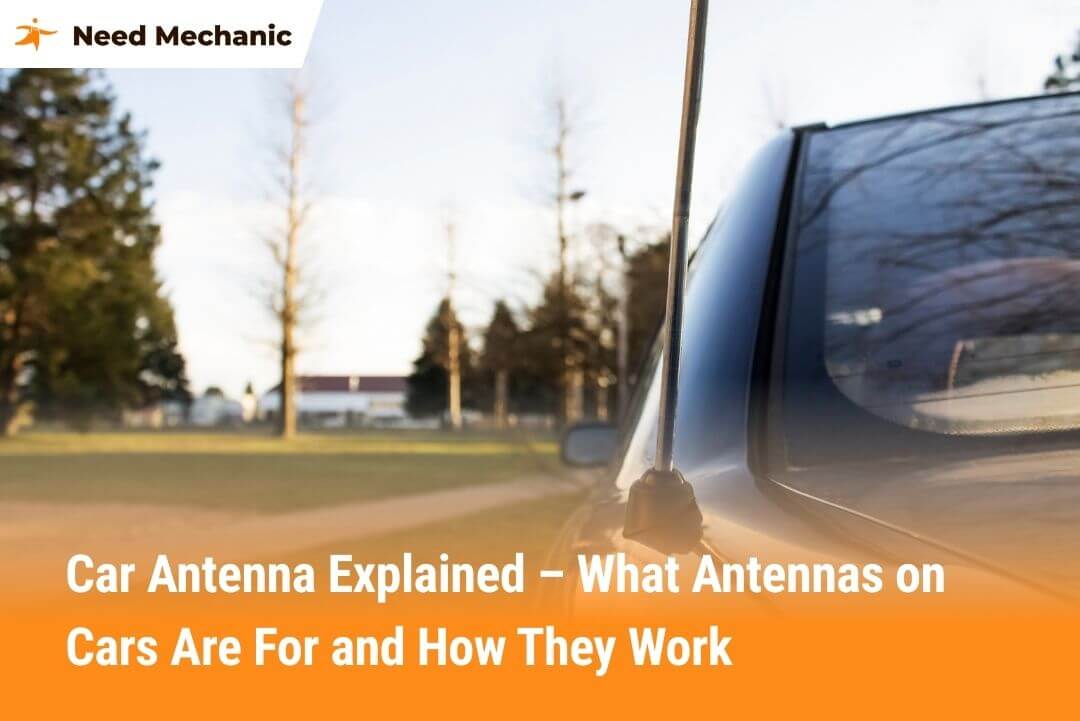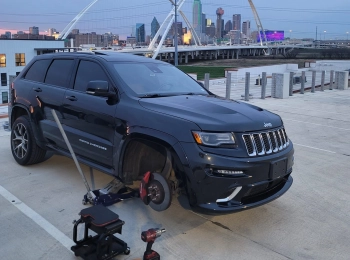Antennas on cars are designed to capture signals like radio, GPS, satellite, and cellular so your vehicle can provide entertainment, navigation, communication, and safety features. They work by receiving invisible electromagnetic waves from towers or satellites and converting them into usable information such as music from FM radio, turn-by-turn GPS directions, or even stronger Wi-Fi signals for passengers.
While many drivers overlook them, antennas are essential for keeping modern cars connected to the world. From classic whip rods to sleek shark fins, they have evolved to serve multiple functions without standing out. In this guide, you’ll learn not just what antennas are for but also how they work, the different types you’ll see on vehicles, common problems, and why they remain vital even in today’s smartphone era.
Table of Contents
Why Do Cars Have Antennas?
The simplest answer is that antennas allow cars to receive and sometimes transmit signals. Cars rely on a variety of communication technologies, and an antenna acts like the gateway between the car and the outside world of invisible radio waves.
Here are the main functions antennas serve:
- Radio reception – Picking up AM and FM signals so drivers can listen to local stations, music, news, and traffic updates.
- GPS navigation – Allowing navigation systems to connect with satellites to provide accurate directions and real-time location tracking.
- Cellular connectivity – Some antennas boost cell signals for in-car Wi-Fi hotspots and connected services.
- Satellite radio – Specialized antennas connect to providers like SiriusXM for premium channels.
- Keyless entry and alarms – Short-range antennas communicate with your key fob to lock, unlock, or start your car remotely.
Without antennas, most of these everyday conveniences wouldn’t be possible.

How Do Car Antennas Work?
Antennas are designed to capture electromagnetic waves and convert them into electrical signals that your car’s systems can understand.
Here’s a breakdown of the process in simple terms:
- Signal transmission – Radio stations, satellites, or cell towers send out signals through the air.
- Signal capture – The car antenna picks up these signals. Its material and length are tuned to specific frequencies, which is why some antennas are longer while others are smaller and hidden.
- Conversion to sound or data – Once received, the car’s radio, GPS unit, or onboard computer processes the signal into sound (radio music, voice navigation) or digital information (maps, Wi-Fi, emergency alerts).
Think of an antenna as a translator that listens to invisible conversations in the air and passes them along in a way you can understand.
Types of Car Antennas and Their Benefits
1. Whip Antennas
These are the tall, flexible rods that used to be common on older vehicles. They provide strong AM/FM radio reception but are less common on modern cars because of their bulky look.
Benefit: Reliable signal, especially in rural areas.
2. Shark Fin Antennas
Shark fin antennas are small, aerodynamic, and usually placed on the car roof. They handle multiple functions, including GPS, cellular, and satellite radio.
Benefit: Sleek design with multi-purpose use.
3. Embedded Antennas
Some vehicles have antennas built directly into the windshield or rear window. These are nearly invisible and designed to blend in with the car’s design.
Benefit: Hidden style with fewer breakage risks.
4. Satellite Antennas
Specialized for satellite radio or GPS services, these antennas pick up signals from orbiting satellites, which is essential for modern navigation and entertainment.
Benefit: Clear reception for GPS and premium channels.
5. Smart Antennas
Found in newer cars, smart antennas combine multiple signal functions into one system. They can handle AM/FM, GPS, Wi-Fi, and even vehicle-to-vehicle communication in advanced models.
Benefit: All-in-one convenience for connected cars.
The Evolution of Car Antennas
Car antennas have changed dramatically over time. Decades ago, most cars had long whip antennas that extended high into the air. These were effective but prone to bending or breaking. In the 1990s and 2000s, manufacturers began hiding antennas inside car bodies or shortening them for style reasons.
Today, the shark fin has become the most common, thanks to its modern look and ability to combine multiple technologies. As vehicles become smarter and more connected, antennas are evolving into small, powerful systems that support Wi-Fi, Bluetooth, 5G, and even autonomous driving communication.
Common Problems With Car Antennas
Even though antennas are small, problems with them can affect your entire driving experience. Some common issues include:
- Poor radio reception – Static or weak signals may mean the antenna is damaged, disconnected, or blocked.
- Broken or bent antenna – Physical damage from car washes or accidents can ruin signal strength.
- Faulty wiring – Internal cables linking the antenna to your car’s systems can wear out.
- Obstructions – Buildings, tunnels, or even trees can interfere with antenna signals.
When drivers ask “Why is my car antenna not working?” the solution is often a simple replacement or repair.
How to Fix or Replace a Car Antenna
If your antenna stops working, you don’t always need a mechanic. Some issues can be solved with simple fixes:
- Check the connection – Loose or corroded connectors may be the problem.
- Inspect for damage – Look for bends, breaks, or missing pieces.
- Replace the mast – On many cars, you can unscrew the old antenna and screw in a new one.
- Upgrade to a universal antenna – Many aftermarket antennas are designed to fit multiple vehicles.
For embedded or shark fin antennas, professional replacement may be necessary since these are wired into multiple systems.
Do You Still Need a Car Antenna in 2025?
Some people assume antennas are outdated now that we have smartphones, streaming services, and Bluetooth. But antennas remain essential for several reasons:
- Emergency alerts – FM radio and satellite connections are often more reliable than mobile networks during natural disasters.
- Navigation accuracy – GPS antennas provide stronger, faster connections than phones alone.
- In-car Wi-Fi – Antennas boost connectivity, especially in rural areas where mobile signals are weak.
- Vehicle communication – As cars move toward self-driving, antennas will handle vehicle-to-vehicle and vehicle-to-infrastructure communication.
The truth is, antennas aren’t going anywhere—they’re just getting smarter.
User Benefits: Why Antennas Still Matter to Drivers
Antennas may not seem exciting, but they offer real benefits for everyday drivers:
- Better entertainment – Clear music, news, and talk radio.
- Reliable directions – Accurate GPS keeps you from getting lost.
- Stronger connections – Better call quality and internet for passengers.
- Safety and security – Integration with alarms and keyless systems.
- Future readiness – Support for 5G and smart car technology.
By understanding what antennas on cars are for, you’ll appreciate how much they improve your driving experience.
The Future of Car Antennas
Looking ahead, antennas will only become more important. As electric vehicles and smart cars dominate the road, antennas will handle constant streams of data, from software updates to safety communication. Some experts predict that future antennas will be fully hidden, ultra-compact, and capable of connecting to multiple satellites, networks, and even traffic lights in real time.
For drivers, this means safer, faster, and more connected travel without needing to think about what’s happening behind the scenes.
Conclusion
So, what are antennas on cars for and how do they work? They are the unseen link that connects your vehicle to the outside world. From radio and GPS to Wi-Fi and smart technology, antennas make modern driving safer, more convenient, and more enjoyable.
Even as designs change from tall whip antennas to sleek shark fins, the purpose stays the same: antennas keep you connected. The next time you see that small piece on your car’s roof or windshield, you’ll know it’s doing much more than you think.
FAQs
What are antennas on cars for?
They are the vehicle’s essential communication link. Antennas are designed to capture signals across the electromagnetic spectrum, including radio (AM/FM), GPS, satellite (SiriusXM), and cellular data. These signals allow your car to provide entertainment, highly accurate real-time navigation, hands-free calling, and crucial safety features like emergency crash response (telematics).
How do antennas on cars work?
An antenna is simply a conductor (usually metal) designed to resonate with specific frequencies. When electromagnetic waves (radio waves) hit the antenna, they induce a tiny alternating electrical current. This current is amplified by a booster or preamp, travels down a coaxial cable, and is decoded by the head unit or car computer into usable data, such as music or map coordinates.
Why do cars still have antennas today?
Antennas are far from obsolete. They are necessary for services that require dedicated, high-gain signals, like reliable satellite radio or high-precision GPS. Moreover, antennas dedicated to receiving public safety signals (like FM for emergency broadcasts) are often more reliable during natural disasters than congested mobile networks. If you suspect an issue with your specialized modern antenna system, you can easily post your service request on NeedMechanic to find a qualified electronics technician.
What types of antennas are used on cars?
Cars use several types: Whip antennas (long rods) are great for low-frequency AM radio; Shark fin antennas (aerodynamic roof units) often house multiple elements for GPS, cellular data, and satellite radio; Embedded antennas are integrated directly into window glass, typically for AM/FM, offering a sleek, hidden appearance but sometimes lower reception quality.
Can a car work without an antenna?
The engine and basic driving functions are unaffected. However, any feature relying on an external signal will fail or degrade significantly. This includes your radio (mostly static), navigation (slow or inaccurate map positioning), and often keyless entry/remote start for some systems. If your vehicle is losing vital connectivity, finding a local expert is fast: use NeedMechanic to find a local mechanic who can assess the wiring and connectivity modules.
What happens if a car antenna is broken?
Physical damage (e.g., from a car wash or vandalism) results in a break in the conductive path, leading to a complete or partial loss of signal. For example, a broken whip antenna might only cause static, but a damaged shark fin could knock out GPS, satellite radio, and onboard Wi-Fi simultaneously, as it contains multiple circuits.
Can I replace or upgrade my car antenna myself?
Simple replacement of a detachable mast antenna (whip) is a common DIY task-you just unscrew the old one and screw in the new. However, replacing or upgrading a multi-functional shark fin or window-embedded antenna requires accessing interior trim, running complex wiring, and correctly connecting the new component to the car’s electronics bus. You can browse local shops specializing in vehicle electronics through the NeedMechanic directory to ensure the job is done right.
Are shark fin antennas better than regular ones?
Shark fins are superior primarily due to their multi-band capability and improved design. They are aerodynamic, rarely broken, and house various antenna elements in one unit, efficiently managing multiple services (GPS, cellular, satellite). They often contain an internal amplifier, which helps boost weak signals. If you are experiencing signal issues with your multi-function fin, a reliable mechanic found through NeedMechanic can quickly test the internal components.
Do antennas affect GPS accuracy?
Absolutely. GPS requires a line-of-sight connection to at least four orbiting satellites to calculate your precise location using trilateration. A high-quality, unobstructed GPS antenna provides a clearer, stronger signal lock than a phone, resulting in faster and more accurate turn-by-turn directions. If your navigation is consistently slow or incorrect, you can use NeedMechanic to post your repair request and get fast quotes from specialists who can check your system’s calibration and components.
Will future cars still use antennas?
Yes, but they will be highly integrated and specialized. As vehicles become “smart,” they require constant, high-speed data flow. Future antennas will handle ultra-fast 5G communication, dedicated vehicle-to-everything (V2X) communication (talking to traffic lights, other cars, and infrastructure), and over-the-air software updates, becoming seamlessly integrated into the car’s body panels.












Leave a Reply